




























































































































































































































































- Designing for circularity: championing materials re-use at 30 Duke Street St James’s
- For What it’s Worth
- Exploring Thermal Labyrinth Ventilation Systems at the Big Data Institute, University of Oxford
- “Discovering magic in the mundane” – Q&A with Ian Hunter, Materials Council
- Retrofit or Rebuild: Getting the most area for the least embodied carbon
- Winner of The Architecture Drawing Prize 2023: an interview with Eldry John Infante
- Developing in the City: New Build vs Retrofit
- Transforming Cityscapes with the Power of Nature
- Making luxury circular: rethinking re-use in retail fit-outs
- Is it mean to cut down trees?
- “Drawing as a method of dialogical design” – an interview with Eugene Tan
- “I’m interested in intricate and intimate architecture that directly affects people.” – Samira
- Refresh, repurpose, reimagine: Our approach to retrofit
- Developing in the City: New Build vs Retrofit Part 2
- Make models: Carlisle Health and Wellbeing Centre
- AI integration at Make: shaping the future of architecture
- Optimising the value of build-to-rent
- Tall buildings photo essay
- Reflections on Make Neutral Day 2024: Part 2
- Is it green to cut down trees?
- Make models: Station Row section model
- Make models: Drum
- Make models: Milton Avenue/Station Row
- Reflections on Make Neutral Day 2024: Part 1
- Defining a sustainable workplace – the BCO’s climate emergency challenge
- Discussing exhibitions with Dr Erin McKellar, Assistant Curator (Exhibitions), Sir John Soane’s Museum
- “Spirit is pure, so that’s what I feel here.” – Aunty Margret
- Hydrogen: Solution or ‘Techcrastination’?
- Carbon goggles: looking for facades of the future by reflecting on facades of our past
- Winning the 2022 Architecture Drawing Prize
- Variety in urban living: setting the scene
- Make models: Salford Rise
- Variety in urban living: the challenges and opportunities
- Make models: Seymour Centre
- Wilding the City
- Make models: 20 and 22 Ropemaker Street gift models
- Variety in urban living: innovation is key
- Reflections on Make Neutral Day 2023: Part 1
- Designing Regenerative Travel
- Make models: Jersey South Hill
- World Heritage Day 2023 Photo Essay
- Reflections on Make Neutral Day 2023: Part 2
- “Let’s do something a bit different”
- A deep dive into an amazing ‘Wunderkammer’
- Make models: shopping centre competition facade
- “My first subject was a house. From then on, I started developing my drawing skills.”
- The Spirit of Mountain
- Make models: Brookfield Place Sydney
- Make models: community library model
- Q&A with Maker Michelle Evans, project lead on Capella Sydney
- Challenging structural conventions at 80 Charlotte Street
- The power of creativity and experimentation
- Hyperlocal retail post-Covid
- Architectural Drawing: From Soane’s Time to Today
- New business models for a different retail future
- Internet shopping and the effect on cities
- The value of outreach – reflecting on our school engagement with RIBA Architecture Ambassadors
- Pink light veggies
- “I’ve wanted to be an architect since I was four years old.”
- “I’m learning that architectural designs will need to work in the real world.”
- The town centre in five years’ time: Community [1/3]
- Make–ReMake
- Embodied carbon of transportation
- From listed buildings to 21st-century schools [2/2]
- Drawing Sydney
- Inspired by “art built” – an interview with Marc Brousse
- Embodied carbon in curtain walls
- Reducing embodied carbon isn’t all about materials
- “Tall buildings mesmerise me.”
- Make models: metal etching
- “I’m the first one in my family pursuing architecture.”
- “What can you see behind this building?” – an interview with Fe
- My next getaway
- The town centre in five years’ time: Wellbeing [2/3]
- Make models: 80 Charlotte Street
- Living Architecture: Urban Forest
- “I want to build things that will explore new depths of the sea.”
- Upfront carbon: how good is good enough?
- The town centre in five years’ time: For everyone [3/3]
- Winner of The Architecture Drawing Prize 2020 – an interview with Clement Laurencio
- Restoring Hornsey Town Hall’s clocks
- A Proposed Hierarchy for Embodied Carbon Reduction in Facades
- From listed buildings to 21st-century schools [1/2]
- Comparing embodied carbon in facade systems
- Building Natural Connections with Energy, People, Buildings
- Bridging the gap
- Designing in the wake of coronavirus
- Living employment
- Atlas – Tech City statement
- Four ways residential design might change after COVID-19
- Post COVID-19 – What’s next for higher education design?
- Inspiring Girls
- Stephen Wiltshire
- The future of retail and workplace
- Make models: The Cube
- International Women’s Day 2020
- Architectural Drawing: States of Becoming
- One Make
- Post-COVID
- The Architecture Drawing Prize exhibition reviewed
- ‘Architecture in the frame’ – London Art Fair
- A Hong Kong perspective on a post COVID-19 society
- Chadstone Link: Making new connections
- Improving social ties in our cities
- Design narratives and community bonds
- Behind the scenes at the 2019 World Architecture Festival
- Drawing on the culture that makes the buildings
- Future modelmakers 2020
- The City is Yours
- After coronavirus, how can we accelerate change in workplace design to improve connection and wellbeing?
- The Madison model by Theodore Polwarth
- Q&A with our student modelmakers: Theodore Polwarth
- The Teaching and Learning Building model by James Picot
- Q&A with our student modelmakers: James Picot
- Pablo Bronstein
- The Big Data Institute model by Finlay Whitfield
- Q&A with our student modelmakers: Finlay Whitfield
- Encouraging spaces of conviviality
- The importance and passion of heritage in the built environment
- No show, so what next?
- Choosing architectural modelmaking
- World Heritage Day 2020
- Make models: Agora Budapest
- Drawing in Architecture
- Draw in order to see
- Project delivery at 80 Charlotte Street
- Our commitment to sustainable design
- Asta House – Local living in Fitzrovia
- Make models: Chadstone Link
- Transparency and a sense of investment
- Langlands and Bell – Observing and Observed
- Telling Stories: The power of drawing to change our cities
- Musings on The Architecture Drawing Prize 2020
- What role will hotels play in our society after COVID?
- Sketchbooks: draw like nobody’s watching
- Honest, in-depth learning
- Museum for Architectural Drawing, Berlin
- Make models: 20 Ropemaker Street, part 2
- The value of the drawing
- The hand does not draw superfluous things
- Balance
- Prized hand-drawings return a building to an organically conceived whole
- Draw to Make
- Drawing details – technical and poetic
- Betts Project
- Living with loneliness
- Combating loneliness in the built environment
- An update from Sydney
- Retail innovation beyond the shop door: Lessons from the USA (part 1)
- Make models: 20 Ropemaker Street, part 3
- Sydney born and razed
- Retail innovation beyond the shop door: Lessons from the USA (part 2)
- Make models: 20 Ropemaker Street, part 1
- Retail innovation beyond the shop door: Lessons from the USA (part 3)
- Architecture and Creativity
- High-density living in Hong Kong
- Make’s past, present and future
- The Architecture Drawing Prize – Not just another competition
- Leaving a mark
- Community connections
- My time with the BCO
- The call of the wild
- The art of an art historian
- Mary, queen of hotels
- Make models: Portsoken Pavilion
- The Make Charter
- Why Brexit will see a glass half-full emptied
- Make models: LSQ London
- Disappearing Here – On perspective and other kinds of space
- Drawing and thinking
- Drawing to an end?
- Making shops exciting again: Lessons from the Nordics (part 1)
- Make models: Grosvenor Waterside
- Drawing architecture
- The Hollow Man: poetry of drawing
- Above and beyond
- Making shops exciting again: Lessons from the Nordics (part 2)
- Plein air in the digital age
- A “Plan in Impossible Perspective”
- Art Editor’s picks
- Making shops exciting again: Lessons from the Nordics (part 3)
- The future of bespoke HQs
- Make models: The Luna
- World-class architecture
- The Architecture Drawing Prize exhibition review
- The future is bright but not the same
- Employee ownership
- The tools of drawing
- Trecento re-enactment
- Lessons on future office design from Asia Pacific
- The human office
- How drawing made architecture
- Advocating sustainable facade design
- Make models: FC Barcelona’s Nou Palau Blaugrana
- Drawing as an architect’s tool
- Are you VReady?
- Cycle design for the workplace
- The Architecture Drawing Prize
- Make models: an urban rail station
- Reporting from Berlin
- City-making and Sadiq
- Hand-drawing, the digital (and the archive)
- Ken Shuttleworth on drawing
- The green tiger
- Stefan Davidovici – green Mars architect
- When drawing becomes architecture
- Make models: Swindon Museum and Art Gallery
- The role of the concept sketch
- Make calls for a cultural shift in industry’s approach to fire safety
- 2036: A floor space odyssey
- Harold on tour
- London refocused
- Hotels by Make
- Full court press
- Digital Danube
- Don’t take a pop at POPS
- The future of architecture – Matthew Bugg
- The future of architecture – Jet Chu
- The future of architecture – Robert Lunn
- The future of architecture – David Patterson
- The future of architecture – Rebecca Woffenden
- The future of architecture – Katy Ghahremani
- Safer streets for all
- The importance of post-occupancy evaluation for our future built environment
- Put a lid on it
- Designing for a liveable city
- The future of architecture – Bill Webb
- Bricks – not just for house builders
- Designing in the City of Westminster
- Rolled gold
- How to make a fine suit
- Responsible sourcing starts with design
- Is off-site manufacture the answer?
- Developing a design for the facade of 7-10 Hanover Square
- Curious Sir Christopher Wren
- Responsible resourcing should be an integral part of every project
- The socio-economic value of people-focused cities

Ken founded Make in 2004 and is a pioneer of the employee ownership model. He acts as guardian of our 150 employees and oversees the design development of every scheme.
Our founder reflects on where we’ve been as a practice, where we’re heading, and some of the highs and lows along the way.
Looking back over the past 15 years, do you have a favourite Make project?
It has to be 5 Broadgate. I think the building was a game changer in terms of office buildings, and for the client, the sustainability agenda and the long-term legacy of the estate. I never set out for Make to design bland, nondescript buildings, but 5 Broadgate was divisive and has pushed the agenda. I’m very proud of what we delivered. I think it’s beautiful – there’s nothing else like it.
What would you say are the projects that ‘got away’?
I was incredibly proud of our competition proposals for the Lord’s cricket ground extension and for FC Barcelona’s new Palau Blaugrana – both would have been amazing to win. But the one I was most disappointed to lose was for Soho in Beijing. Our design was really ambitious and beautiful, a flamboyant archway with a superb facade, and I was sad to miss out on the chance to build it.
If you could change one thing about Make’s history, what would it be?
Probably the need for redundancies due to projects stopping. Our Makers are what make this practice what it is, and it never gets any easier making those sorts of business decisions.
How has the industry changed since Make was established 15 years ago?
The focus on technology is in an entirely different league now – we have VR headsets used as part and parcel of our project design and models run off the 3D printers overnight. We use BIM and Revit in design, which has streamlined the process, and we have modular and pre-fab construction, which was only in its infancy when we started up. Tech has opened up a wealth of opportunities. I still have my 0.9 Pentel pencil and sketch pad, though.
What would your advice be for someone starting out now?
My top tips would be:
- Never take yes for an answer. I learnt this saying over 45 years ago, and the past 15 years have shown that it doesn’t wane as a fundamental principle of working in this industry. Question everything, especially the answers you get!
- Develop a thick skin if you have opinions.
- Build up a strong network of contacts and keep in touch with them. You never know where the next job will come from.
- Keep tech at the curve of creativity. Invest, collaborate and partner up to keep moving forwards.
- Step outside of your comfort zone. The learning curve is incredibly steep, but lack of preconceptions affords a huge opportunity for creativity, so use it!
After 15 years of Make, what do you think sets it apart from any other practice?
I think curiosity and being totally design-focused are the key to all our projects. Collaboration and giving back are also crucial. We do so much to embed ourselves in the industry and work with experts in other fields through initiatives like the Future Spaces Foundation, our new Exchange series and The Architecture Drawing Prize, and by mentoring for fantastic organisations like the Stephen Lawrence Charitable Trust. These ambitions stand outside of our commercial architecture work and enrich us deeply as a practice.
And of course the employee ownership model is so important in the way we set up Make. It’s one of the things I’m proudest of – that everyone is credited for what they design and produce. It’s fundamental to the way Make works, and I’m delighted that so many other practices have emulated parts of the model, having witnessed its success. That said, none have been brave enough yet to go 100% employee-owned!
There have been some infamous Make parties over the years – which one stands out in your memory?
To spare the blushes of our friends and clients, I’ll choose a Make-only party. There was a classic Christmas party in 2006, in a church of all places, in Birmingham. It was rather more luxe than our usual affair, but it still ended up with Make Band guitar solos from the pulpit and involuntary fancy dress outfits.
London’s party for 2018 was far less elaborate – we held it in our studio – but it reminded me of the early Make days. It was wonderfully innovative, with a crazy golf course made by our own modelshop and lots of bright costumes.
Any client-related howlers over the years?
We once pitched for a masterplan with a metal model that ripped a gash in the client’s mahogany board table! And another time we were at a major public exhibition with the client and council representatives, and the public realm board had the word ‘public’ spelt out in huge letters – with the L missing.
Where do you see Make in the next 15 years?
I think we’ll have some fantastic, profile-raising infrastructure projects on the books and hopefully more public places too. I hope to see more places, spaces and buildings that lift the spirits and change people’s lives for the better.
We’ve built 84 fantastic projects since we started Make, which is incredible and unbelievable, really – way beyond our expectations. We’ve managed to achieve ten times over what we set out to do. And it already feels like a wonderful legacy.
Article extracted from Make Annual 15.



























